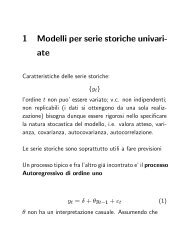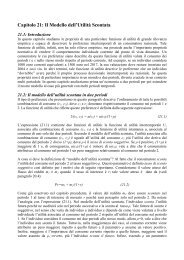algebra lineare tracce d'esame - Dipartimento di Scienze Economiche
algebra lineare tracce d'esame - Dipartimento di Scienze Economiche
algebra lineare tracce d'esame - Dipartimento di Scienze Economiche
You also want an ePaper? Increase the reach of your titles
YUMPU automatically turns print PDFs into web optimized ePapers that Google loves.
Corso <strong>di</strong> laurea in <strong>Scienze</strong> Statistiche ed <strong>Economiche</strong><br />
Prova scritta <strong>di</strong> ALGEBRA LINEARE - 13 luglio 2005<br />
***********<br />
n. 1 - Dati i vettori u1 = (1, 1, 0, −1) T , u2 = (−1, 0, 2, 2) T e u3 = (0, 1, 3, −2) T ,<br />
a) verificare in base alla definizione che tali vettori sono linearmente in<strong>di</strong>pendenti;<br />
b) calcolare il determinante della matrice avente per colonne i vettori u1, u2, u3 ed u4 = (2, 1, −3, 0) T ,<br />
c) detto U il sottospazio <strong>di</strong> R 4 generato da u1, u2, u3, u4 , in<strong>di</strong>care la <strong>di</strong>mensione ed una base <strong>di</strong><br />
U e (con il proce<strong>di</strong>mento <strong>di</strong> Gram Schmidt), ricavare una base ortogonale <strong>di</strong> U da tale base.<br />
n. 2 - Dati i vettori u1 = (1, 2, h − 1) , u2 = (2, 5, −1) e u3 = (h, 1, 1),<br />
a) <strong>di</strong>re per quali valori del parametro h tali vettori sono linearmente <strong>di</strong>pendenti o in<strong>di</strong>pendenti;<br />
b) al variare del parametro h, trovare la caratteristica della matrice A avente per righe tali vettori;<br />
c) trovare il complemento ortogonale allo spazio U generato da tali vettori, precisando la <strong>di</strong>mensione<br />
<strong>di</strong> U e <strong>di</strong> U ⊥ ed in<strong>di</strong>cando una base <strong>di</strong> tali sottospazi;<br />
d) <strong>di</strong>re per quale valore del parametro h il sistema <strong>lineare</strong> non omogeneo Ax = y con y =<br />
(0, 1, −1) T é determinato, indeterminato o incompatibile, e trovare le eventuali soluzioni del sistema;<br />
e) scrivere le equazioni della trasformazione <strong>lineare</strong> LA associata alla matrice A avente per righe tali<br />
vettori,<br />
f) trovare il nucleo e l’immagine <strong>di</strong> tale trasformazione <strong>lineare</strong>, in<strong>di</strong>candone esplicitamente la <strong>di</strong>mensione<br />
ed una base;<br />
g) trovare il complemento ortogonale al nucleo ed all’immagine <strong>di</strong> LA, in<strong>di</strong>cando anche <strong>di</strong> tali sottospazi<br />
la <strong>di</strong>mensione ed una base.<br />
n. 3 - Date le metrici<br />
⎛<br />
2<br />
A = ⎝ 1<br />
−2<br />
0<br />
⎞<br />
0<br />
2 ⎠ e<br />
⎛<br />
3<br />
B = ⎝ −2<br />
2<br />
−1<br />
⎞<br />
−2<br />
2 ⎠ ,<br />
0 1 2<br />
2 2 −1<br />
a) trovare la matrice trasposta <strong>di</strong> A, la matrice A − 2 · B e la matrice prodotto B · A;<br />
b) <strong>di</strong>re se B é invertibile e trovarne l’(eventuale) matrice inversa B −1 ;<br />
c) trovare gli autovalori e i corrispondenti autospazi <strong>di</strong> A e <strong>di</strong> B,<br />
d) <strong>di</strong>re se tali matrici sono <strong>di</strong>agonalizzabili e (in caso affermativo) trovare una base <strong>di</strong> R 3 formata <strong>di</strong><br />
autovettori.<br />
n. 4 - Con il criterio del segno degli autovalori e con il criterio <strong>di</strong> Sylvester stu<strong>di</strong>are il segno della forma<br />
quadratica associata alla matrice quadrata simmetrica<br />
⎛<br />
a<br />
⎝ 2<br />
2<br />
1<br />
⎞<br />
0<br />
−1 ⎠ .<br />
0 −1 2<br />
1


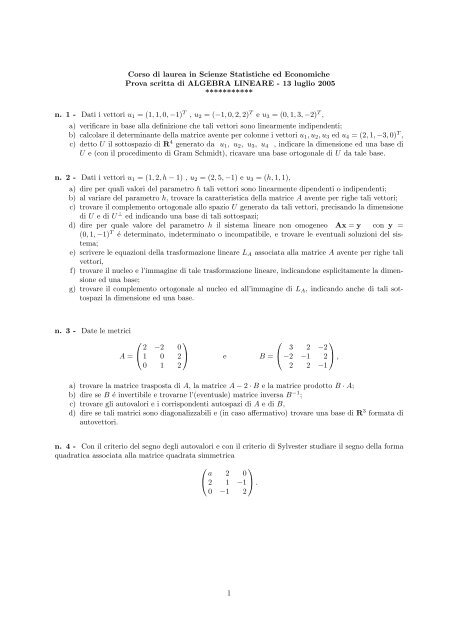
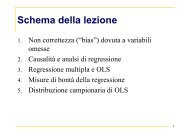



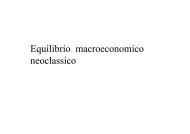

![[ ]](https://img.yumpu.com/14935362/1/184x260/-.jpg?quality=85)
